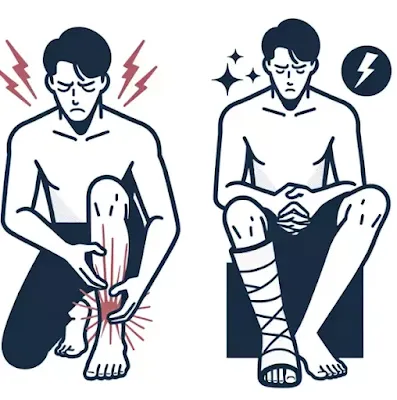You're sprinting down a garden path, enjoying the world around you, when suddenly, your foot twists in an unexpected direction. Now, you're clutching your ankle to determine if it's a sprain or a fracture. The pain is intense, your fibula itches like nothing else, and you only want to put weight on your ankle but can't. In such moments of uncertainty, how would we know if it’s just a minor sprain or something more serious like an ankle fracture?
So, sprained ankle vs broken ankle, what's the difference? Here's what you need to know.
Sprained vs Broken: Understanding the Basics
Understanding the nature of each injury is at the core of knowing the difference. An ankle sprain involves an injury to the ligaments connecting the bones in the foot and ankle. These ligaments can be partially or completely torn, leading to varying levels of ankle pain. On the other hand, a broken or fractured ankle means one of the three bones in your ankle has suffered a crack or break.
Identifying a Sprained Ankle
The difference between an ankle sprain and a break often lies in the type of pain and the location. If you experience pain in the softer part of the ankle, it’s likely a sprain. A sprain results from rolling your ankle or a similar twisting motion that stretches the ligaments beyond their normal range of motion.
Ankle sprains can be classified into three grades:
- Grade 1 sprain: This is a mild sprain where the ligaments are stretched but not torn.
- Grade 2 sprain involves partial ligament tearing, resulting in swelling and bruising.
- Grade 3 sprain: This is a severe sprain where the ligament is completely torn, often accompanied by significant swelling and pain.
Recognizing a Broken Ankle
The ankle is broken if the pain is directly over your ankle or any part of the ankle bone. Another strong indication is if you heard a ‘grinding’ or ‘crunching’ sound at the time of the injury. Events like falls, car accidents, or a heavy object dropping on the foot can lead to a broken ankle.
Similar Symptoms and How to Distinguish
Both sprained and broken ankles can result in swelling, bruising, and an inability to move your ankle in its normal range of motion. It makes it hard to tell if it’s a sprain or a fracture. While tenderness in the softer part of the ankle may suggest a sprain, any loss of blood flow, numbness, or exposed bone necessitates immediate medical attention.
Seeking Medical Insight
The best way to know if you’ve sprained or broken your ankle is to have a medical professional examine your ankle. They might order an X-ray or an MRI, which will clearly show if there's a crack in the bone or an injury to the ligaments. If you suspect you’ve injured your ankle, always seek medical attention.
Treatment Options: Ankle Treatment for Every Injury
Sprained Ankle Treatment
For sprained ankles, the initial treatment involves the R.I.C.E method – Rest, Ice, Compression, and Elevation. Depending on the severity, you may also need to immobilize the ankle with a brace or boot. Physical therapy can speed your recovery and ensure your ankle regains strength and flexibility.
Broken Ankle Treatment
For a broken or fractured ankle, the course of treatment can vary. Minor breaks require immobilizing the ankle with a boot or cast. More severe fractures, where the bones have become displaced, might need surgery to realign and fixate the bones.
Recovery Time: From Hurt to Healed
Ankle sprains and ankle fractures differ in their recovery time. A grade 1 sprain might heal in a week or two, whereas a grade 2 or 3 sprain could take several weeks to months. Depending on the method of treatment and severity, broken ankles can take several weeks to months for full recovery.
Conclusion: Knowing is Half the Battle
Knowing the difference is crucial for proper treatment when it comes to a sprained or broken ankle. While they share similar symptoms, the method of treatment and recovery time can differ substantially. Whether you’ve sprained or broken your ankle, ensure you get the right treatment plan to safely return to your normal activities.


.webp)